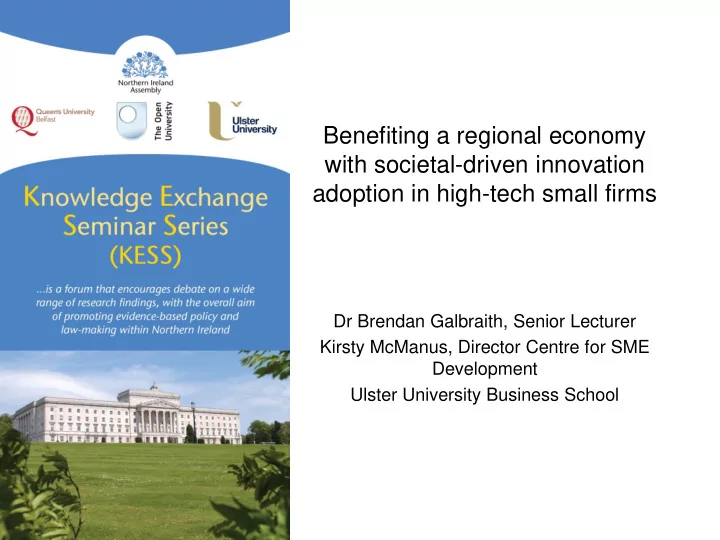

Benefiting a regional economy with societal-driven innovation adoption in high-tech small firms Dr Brendan Galbraith, Senior Lecturer Kirsty McManus, Director Centre for SME Development Ulster University Business School
Overview: • Rethinking Innovation • The Big Societal Challenges • Rethinking the Start-up Model • Societal Innovation Models • Innovation adoption in the social sector • Policy and future developments
The Linear View of InnovationLinear (Closed) Model • Policy emphasis on inputs & outputs. Easy to measure • Accepted wisdom of RBV of firm & large internal R&D capabilities • European Paradox. Lack of innovative SMEs & collaboration • Linear view too simplistic – does not capture complexity of innovation • Line between R&D is blurred, 1:1000 ideas = commercial success
The Big Societal Innovation Challenges Europe 2020 strategy - € 29 billion allocation for societal challenges Complex & risky problems call for diverse types of knowledge, resource, participation and collaboration. Behaviour change requires the motivation of millions of individuals and their communities; solutions cannot be pushed. Eg Nokia SMS No matter what functionality a product offers its the ease of use that is the key differentiator particularly in relation to technology-based products and services. New, distributed and highly participatory systems imply new roles for public and private spheres: demand/user/citizen driven open RDI enabled by ICT for service creation. 4
Re-thinking the Traditional Start-Up Model Pre-Start Post- Start Valley of Death- Source Get Idea Develop a Launch See if anyone will Funding/ Validation business plan Business buy my product. Resources Have an Idea Get Set-Up Guidelines 5
Rethinking innovation: European Paradox Phase 0 Phase 1 Phase 3 Phase 4 Phase 2 Research Solution proposal Pre-commercial Commercial Prototype product/service product/service Innovation Market pull Research push “ no man ’ s land ”
New Start-up Model Attempts to prematurely scale is No 1 reason that ambitious business start-ups fail ( Source: Start-up Genome)
Start up culture helps innovation adoption
Societal Innovation: Users, Technology & Market If market and technology are the only factors, the outcome will have low acceptance among people. Market Low acceptance Technology Old- Un- fashioned economical If only If technology and market and society society in turn are filters are included, included, the solution the result will be may be uneconomical. old-fashioned. Society
Societal Innovation Business Model Innovation Space Program: Arizona State University Useful, useable and desirable to consumers What’s desirable? Integrated Innovation What’s possible? What’s valuable? Create real market value Appropriate technology & materials What’s good? Improve society and the environment
Example: Ulster Living Lab - User-driven Quadruple Helix 2. academics can -Users are the subject facilitate knowledge -State-Bus-Acad-Users - Appropriation transfer preparatory -Bottom up seed project activities Sport SMEs Business ICT Development Agencies Knowledge & Technology Academic Business Transfer Business Mentors Innovation Health Models Entrepreneurs Care User Economic Needs Benefit 1. community helps to identify user need Community Community 3. business develops to inform academic Groups Well-being products and services activities in-place in the Charities Health & community & Carers Education Regional Government
Innovation Adoption in the Social Sector More than $1 trillion annually flows through nonprofit organizations in the US An important intermediary between firms and government Source of innovative ideas and policies Source of alternative delivery mechanisms Bottom up, vs. top-down What distinguishes effective nonprofits/social enterprises?
What distinguishes effective social enterprises? “ The secret to success…[in nonprofits] Grow with authenticity” by: has more to do with how nonprofits work outside the “Remaining focused on your core mission” boundaries of their organizations than how they manage their own “Be on purpose, stay on purpose” internal operations ” “Spend a lot of time on how you measure social impact” “Do what you are good at & partner the rest” “Clear criteria on who you partner with… baby steps” (International social franchise service providers, Emerge 2014)
What distinguishes effective social enterprises? Advocacy • Adaptation Engag Work • Shared e with Leadership People markets Collaborate with other Source: adapted from Sources for Good Organisations
FP7 Project: MAPEER SME (Making Progress & Economic Enhancement a Reality for SMEs) • 15 partners covering EU27 & Bosnia & Herzegovina • Total Project value @ € 1.5 million • How to pave the way for SME-friendly R+D+I programmes? • To identify, map and analyze all those programmes and initiatives that assist the collaboration between science and SMEs • Inputs: 185 R&D programmes, @800 SMEs surveyed, 30+ round table meetings, 4 x EEP meetings www.mapeer-sme.eu
MAPEER SME Policies & NI Contextons 10 Open innovation – orientated policy recommendations voiced by SMEs • Policies can promote quadruple-helix collaboration & seed bottom-up projects • SME-SME collaborations have significant impact • Universities perceived as of major importance for SME collaboration • OI policies can recognise process of R&D&I not just linear – ‘inputs & outputs’ • Policy can help integrate & protect the tailored involvement of SMEs in R&D&I projects • Spin research into existing SMEs (eg. Special Effects) • UK University REF increasing emphasis on impact (economic and/or social)
21st ICE & IEEE In Inte tern rnationa ational Technology Management Conference 22 nd – 24 th June 2015, Belfast, Northern Ireland “Engineering Solutions for Societal Challenges” Local organiser/Chair: Dr. Brendan Galbraith Ulster University Business School, County Antrim, Northern Ireland @ICE_Conference b.galbraith@ulster.ac.uk www.ice-conference.org
SME CENTRE AT ULSTER UNIVERSITY BUSINESS SCHOOL Vision: “The Centre for SME Development (CSMED) is a trusted source of business growth expertise and support. We deliver leading practical knowledge and skills and develop long-lasting business networks through the active involvement of successful entrepreneurs and internationally recognised academics. CSMED will advance an agenda around innovation, competitiveness and other business values on behalf of the SME community” Strategic Aims: • Create and promoting flagship management and leadership programmes for growth orientated SMEs; • Support innovation, capability building and competitiveness amongst SMEs; • Become a thought leader and source of best practice for SMEs via our events, research and knowledge transfer activities and publications.
Recommend
More recommend